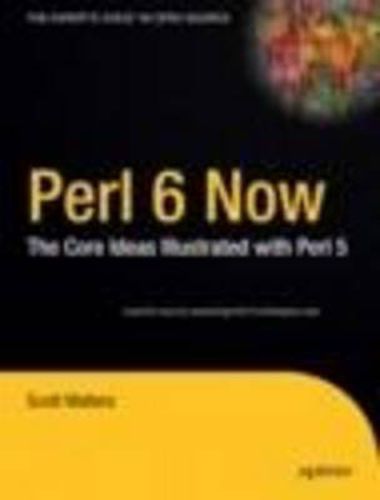Readings Newsletter
Become a Readings Member to make your shopping experience even easier.
Sign in or sign up for free!
You’re not far away from qualifying for FREE standard shipping within Australia
You’ve qualified for FREE standard shipping within Australia
The cart is loading…






This title is printed to order. This book may have been self-published. If so, we cannot guarantee the quality of the content. In the main most books will have gone through the editing process however some may not. We therefore suggest that you be aware of this before ordering this book. If in doubt check either the author or publisher’s details as we are unable to accept any returns unless they are faulty. Please contact us if you have any questions.
Perl 6 Now: The Core Ideas Illustrated with Perl 5 is perfect for those eager to see where Perl is headed, Perl 5 programmers who want to know that their favorite tricks will still work in some form, and programmers wishing to open their minds to advanced programming topics. Perl 6 generalizes the language, making it more extensible, eliminating longstanding pitfalls, and adding new concepts. Thanks to some clever people and impressive efforts, many of these new features work in Perl 5, so you can start using them now in production-level code. The book teaches the basics from a Perl 6 perspective, touching on variable interpolation, datastructure use, object construction, threads, closures, symbol tables, and other core features. It then introduces continuations, coroutines, binding (or aliases), hyper operators that work on lists of data at once, set operators that work on complex datatypes, lightweight multidimensional arrays, strong type checking, autoboxing, precompilation, automatic module dependency installation, and more. Though Perl 6 changes the fundamental syntax in some areas, Perl 5 code isn’t left in the lurch. Thanks to PONIE, code from both versions may coexist in a single program. You’ll need to adjust only a few habits and learn a few new things, and this early adopters guide will help you do these things. Table of Contents * The Programmer’s Introduction to the Perl Computer Programming Language * Perl 6 Road Map * Stricture by Default * Text, Numbers, and Other Constant Data * Names, Containers, and Values * Operators * Multidimensional Arrays * Data Structures * Switch * Block Structure * Subroutines * CPAN Modules * Objects * Exceptions * Type Safety * Multithreading * Any and All * Lexical Closures * Continuations * Coroutines
$9.00 standard shipping within Australia
FREE standard shipping within Australia for orders over $100.00
Express & International shipping calculated at checkout
This title is printed to order. This book may have been self-published. If so, we cannot guarantee the quality of the content. In the main most books will have gone through the editing process however some may not. We therefore suggest that you be aware of this before ordering this book. If in doubt check either the author or publisher’s details as we are unable to accept any returns unless they are faulty. Please contact us if you have any questions.
Perl 6 Now: The Core Ideas Illustrated with Perl 5 is perfect for those eager to see where Perl is headed, Perl 5 programmers who want to know that their favorite tricks will still work in some form, and programmers wishing to open their minds to advanced programming topics. Perl 6 generalizes the language, making it more extensible, eliminating longstanding pitfalls, and adding new concepts. Thanks to some clever people and impressive efforts, many of these new features work in Perl 5, so you can start using them now in production-level code. The book teaches the basics from a Perl 6 perspective, touching on variable interpolation, datastructure use, object construction, threads, closures, symbol tables, and other core features. It then introduces continuations, coroutines, binding (or aliases), hyper operators that work on lists of data at once, set operators that work on complex datatypes, lightweight multidimensional arrays, strong type checking, autoboxing, precompilation, automatic module dependency installation, and more. Though Perl 6 changes the fundamental syntax in some areas, Perl 5 code isn’t left in the lurch. Thanks to PONIE, code from both versions may coexist in a single program. You’ll need to adjust only a few habits and learn a few new things, and this early adopters guide will help you do these things. Table of Contents * The Programmer’s Introduction to the Perl Computer Programming Language * Perl 6 Road Map * Stricture by Default * Text, Numbers, and Other Constant Data * Names, Containers, and Values * Operators * Multidimensional Arrays * Data Structures * Switch * Block Structure * Subroutines * CPAN Modules * Objects * Exceptions * Type Safety * Multithreading * Any and All * Lexical Closures * Continuations * Coroutines